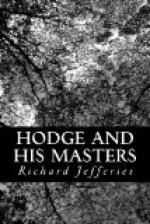On the sheltered sunny bank lie the maple leaves fallen from the bushes, which form a bulwark against the north wind; they have simply dropped upon the ivy which almost covers the bank. Standing here with the oaks overhead and the thick bushes on the northern side it is quite warm and genial; so much so that if is hard to realise that winter is at hand. But even in the shortest days, could we only get rid of the clouds and wind, we should find the sunshine sufficiently powerful to make the noontide pleasant. It is not that the sun is weak or low down, nor because of the sharp frosts, that winter with us is dreary and chill. The real cause is the prevalence of cloud, through which only a dull light can penetrate, and of moisture-laden winds.
If our winter sun had fair play we should find the climate very different. Even as it is, now and then comes a break in the masses of vapour streaming across the sky, and if you are only sheltered from the wind (or stand at a southern window), the temperature immediately rises. For this reason the temperatures registered by thermometers are often far from being a correct record of the real weather we have had. A bitter frost early in the morning sends the mercury below zero, but perhaps, by eleven o’clock the day is warm, the sky being clear and the wind still. The last register instituted—that of the duration of sunshine, if taken in connection with the state of the wind—is the best record of the temperature that we have actually felt. These thoughts naturally arise under the oaks here as the bright sunlight streams down from a sky the more deeply blue from contrast with the brown, and buff, and yellow leaves of the trees.
Hark! There comes a joyous music over the fields—first one hound’s, note, then two, then three, and then a chorus; they are opening up a strong scent. It rises and falls—now it is coming nearer, in a moment I shall see them break through the hedge on the ridge—surely that was a shout! Just in the very moment of expectation the loud tongues cease; I wait, listening breathlessly, but presently a straggling cry or two shows that the pack has turned and are spread wide trying to recover. By degrees the sounds die away; and I stroll onwards.
A thick border of dark green firs bounds the copse—the brown leaves that have fallen from the oaks have lodged on the foliage of the firs and are there supported. In the sheltered corner some of the bracken has partly escaped the frost, one frond has two colours. On one side of the rib it is green and on the other yellow. The grass is strewn with the leaves of the aspen, which have turned quite black. Under the great elms there seems a sudden increase of light—it is caused by the leaves which still remain on the branches; they are all of the palest yellow, and, as you pass under, give the impression of the tree having been lit up—illuminated with its own colour. From the bushes hang the red berries of the night shade,




